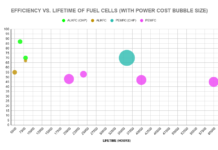by Debra Fiakas CFA
This afternoon FuelCell Energy, Inc. (FCEL: Nasdaq) is scheduled to report results for its fiscal third quarter ending July 2012. As its corporate name suggests the company produces fuel cells for use as power plants or grid alternatives. FuelCell has customers, but has yet to reach profitability. No embarrassment there. None of the other U.S.-based fuel cell producers has delivered earnings to shareholders either and two have had to file for bankruptcy protection.
Journalists have made light of fuel cell developers as perpetually unprofitable. Last year one even made a list of profitable companies. It was blank. More recently another reporter in another article spoke only of companies that have thrown in the towel on fuel cell technology.
Should investors give up on FCEL and fuel cell technology?
I think it would be premature. U.S. investors have a tendency to make decisions from headlines, which often accentuate the negative for attention. To reach the two newspaper articles one might assume fuel cells are a technology that is not commercially viable. Indeed, Ballard Power Systems (BLDP: Nasdaq) may be on the cusp of profitability as the consensus estimates published by Thomson-Reuters suggest an expectation of profit in the December 2012 quarter. Ballard produces proton exchange membrane (PEM) fuel cells for both stationery and vehicle power solutions and is consistently, even if slowly, winning new customers.
Investors also often reference only U.S.-based alternative power companies. They leave out the oft-times exceptional accomplishments of energy developers in other countries. In the fuel cell space investors should look carefully at SFC Energy AG (SSMFF: OTC) , which reported a solid profit in the first half of 2012. SFC is an ambitious operation with direct methanol fuel cells for stationery, mobile and portable applications.
Most of the fuel cell developers have been toiling away for decades perfecting the complex chemistries that allow fuel cells to convert gases such as natural gas, coal gas or landfill methane directly to electricity. Then they had to figure out how to insert this technology into the structures of transportation and industry without requiring a costly rework. The combustion step that has got Earth in such trouble with global warming is completely eliminated. Instead fuel cells “reform” the gas source into hydrogen that is then electrochemically turned into an electrical charge. How investors could think it would be possible accomplish this feat in just a few quarters might be just a bit naive.
FuelCell management has great expectations for its own advance to profits sometime in the year 2013. It is a milestone that has been a long time in coming. FuelCell has been around since 1969 and did not get a commercial fuel cell off the development bench until 2003. The company’s annual production rate based on the megawatt power capacity of its units is somewhere in the high 50s. Management has indicated that it needs to reach a production run rate near 90 megawatts to reach breakeven.
FuelCell’s success now appears to hinge on business development. It really is not a matter of capturing market share. Instead FuelCell’s team needs to create a market by convincing potential customers that a fuel cell the size of a small house is a better alternative than a combustion engine and a fossil fuel supply. The company’s website provides several customer cases, including an educational institution, a power plant and a wastewater treatment plant. FuelCell has made some progress in better defining target markets and more effectively deploying sales and technical personnel. Market partners may be an even better weapon.
In April 2012 South Korea’s POSCO Energy took an equity position in FuelCell (20.0 million shares at $1.50 per share). POSCO’s previous order for 70 megawatts of fuel cells was accelerated and another 120 megawatt order tacked on the end. FuelCell expects a base of production near 40 megawatts per year from the POSCO deal. POSCO Energy has also licensed FuelCell’s technology and will manufacture fuel cell components in Korea at its own facility. I believe the POSCO relationship is a major breakthrough for FuelCell and is clearly a key to securing those elusive profits.
FuelCell can also take some solace from one of the other fuel cell developers. Neah Power Systems (NPWZ: OTC/BB) has been struggling. However, in June 2012, Neah won an order for one its fuel cell units from a U.S. defense contractor. Dependence upon the U.S. electric grid is a point of vulnerability for U.S. military installations, which are responsible for rapid response in catastrophic events such as terrorist attacks or natural disasters. Neah’s fuel cell will be evaluated for use in remote power stations, unmanned underwater and aerial vehicles
The market place is clearly more disposed to consider fuel cells as an alternative to conventional power solutions. It is much too early to count out any of the fuel cell developers.
Debra Fiakas is the Managing Director of Crystal Equity Research, an alternative research resource on small capitalization companies in selected industries.
Neither the author of the Small Cap Strategist web log, Crystal Equity Research nor its affiliates have a beneficial interest in the companies mentioned herein. FCEL, BLDP, NPWZ and SFC are included in the Fuel Cell Group of Crystal Equity Research’s Mothers of Invention Index.







